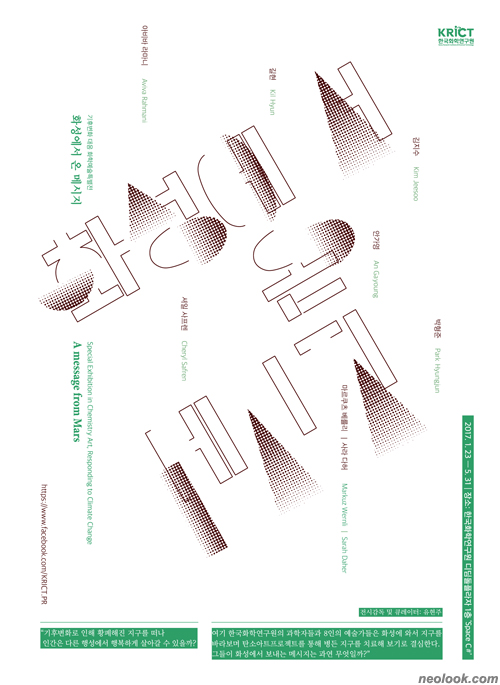- ● homepage
- ● archives
- ● restoration
- ● books
- ● big banners
- ● post board
- ■ neo's search
- ■ about us
- ■ 게재방법 안내
- 개인정보처리방침

- [email protected]
- Tel. 02_335_7922
- Fax. 02_335_7929
- 10:00am~04:30pm
- 월요일~금요일
- 3/3(월) 대체공휴일

화성에서 온 메시지 A message from Mars
기후변화 대응 화학예술특별展 Special Exhibition in Chemistry Art, Responding to Climate Change 2017_0123 ▶ 2017_0531 / 주말 휴관
별도의 초대일시가 없습니다.
참여작가 아비바 라마니_셔일 샤프렌_마르쿠츠 베를리+사라 다허 길현_안가영_김지수_박형준
주최 / 한국화학연구원 협력지원 / 한국화학연구원 과학혁신팀 (주)우인 기획 / 큐레이터 유현주
관람시간 / 10:00am~06:00pm / 주말 휴관 * 전시관 및 연구원 사정에 따라 변동 가능
스페이스 씨샵 SPACE C# 대전광역시 유성구 가정로 141 한국화학연구원 디딤돌플라자 1층 Tel. +82.(0)42.860.7114 www.facebook.com/KRICT.PR
지구가 푸른 초원의 행성이라면 화성은 태양빛으로만 빛나는 붉은 행성이다. 지구의 기후변화로 인해 생존의 위기가 닥쳤을 때, 지구와 가장 유사한 조건을 갖춘 것으로 알려진 화성에서 인간은 과연 생존할 수 있을까? 영화 마션(The Martian)에서의 주인공이 했던 것처럼, 인간은 화성에서 감자를 심고 지구와 같은 땅을 만들어(Terraforming) 농사를 지으며 행복하게 살아갈 수 있을까? 그런데 궁금하다. 왜 그래야만 하는가! 지구는 곧 병든 행성이 되어버릴지 모른다는 것인가? ● "화성에서 온 메시지"의 8인의 예술가들과 한국화학연구원의 과학자들의 생각은 조금 다르다. 이들은 거꾸로 화성에서 지구를 바라보며, 기후변화의 문제를 심각하게 고민한다. 여기 화학연구원 과학자들은 놀랍게도 쓰레기 이산화탄소를 자원으로 활용하여 다양한 기초화학소재를 만드는 첨단화학기술로 기후변화 문제를 해결하고자 한다. 마찬가지로 예술가들 역시 기후변화의 문제를 인식하고 생태적 위기를 화학기술의 방법론과 융합된 자신들만의 언어로 표현한다.
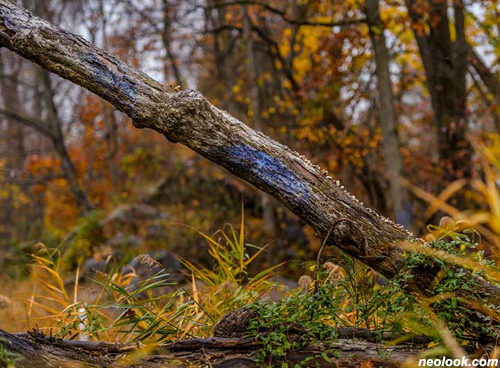
- 아비바 라마니_The Blued Trees Symphony_나무, 페인트, 음향_가변크기_2016
미국의 생태과학예술가 아비바 라마니의 「The Blued Trees Symphony」는 지구의 해수면 상승이후의 변화된 대륙을 묘사하고 거기에 여전히 서식지가 안정된 상태로 남은 장소들을 표시하는 지도를 만든다. 그녀는 그 지도와 함께 설치되는 나무들을 오선지 삼아 자연의 음악을 들려주고자 한다.
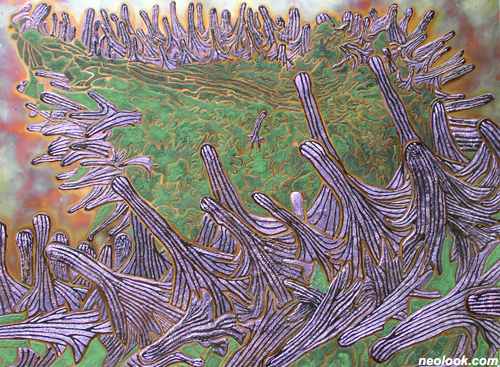
- 셔일 사프렌_Promontorium Protrusia_구리, 화학복합물_91.5×122cm_2016
화학예술가 미국작가 셔일 사프렌은 구리 위에 화학적 복합물로 그려진 세 개의 그림 「Promontorium Protrusia」 「Round 'n Round」 「Und 'n Undone」을 통해 이산화탄소가 식물에 영향을 미치는 방식을 보여준다. 이산화탄소의 증가에 강하게 반응하는 생물종들이 산소에 의존하는 생물종을 제압하는 작품의 이미지들은, 오늘날 생태적으로 지속가능한 사회란 어떤 것인지의 질문을 우리에게 던져준다.
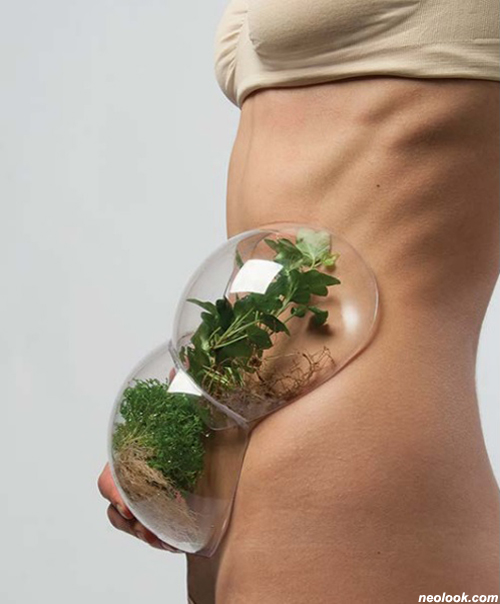
- 사라 다허, 마르쿠츠 베를리_Aquaforming, Mars!_ 소변, 씨앗, 인명 식물 키우기 세트, 유리시험관_가변크기_2016
스위스작가 마르쿠츠 베를리와 브라질 출신의 네덜란드 디자이너 사라 다허의 작업 「Aquaforming Mars!」는 좀 더 적극적으로 화성과 지구간의 연결을 생각한다. 이들은 인간의 소변을 사용해 식물을 자라게 하는 생화학적 실험을 통해 물이 없는 화성에서도 생존하는 방식을 구상한다. 즉 인간과 박테리아와 식물들 사이의 대화 그리고 '지구화'가 아닌 '아쿠아포밍' 방식을 관객과 함께 실현하고자 한다.

- 길현_Rainbow bottle_시약병, 요소_가변크기_2016
길현작가의 작품 「자생화」는 인공적 화학물(요소Urea) 자체가 스스로 자라나고 꽃을 피워내는 자연으로 인식하는 작업이다. 생태적 성장의 원리가 화학의 유기물 속에서도 확인된다.
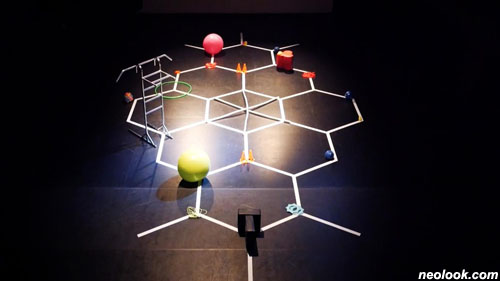
- 안가영_C6_육각형 나무 패널에 C 프린트_35×35cm_2017
안가영작가는 탄소에 대한 게임 작품인 「케미컬 댄스」를 통해, 새로운 물질을 탄생시키는 탄소에 깃든 아름다운 생명력을 보여준다. 화성에서도 이러한 생명의 출발은 탄소에서 시작되지 않을까.
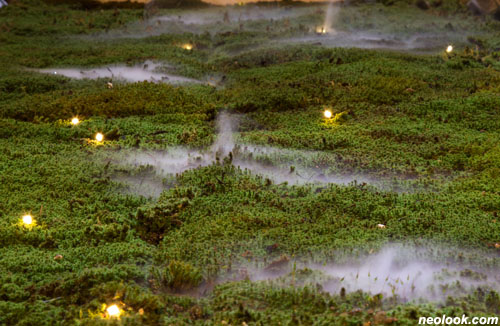
- 김지수_Breathing-II_이끼, 나무, 와이어, 아두이노, LED, 호스, 물_228×72×75cm_2016
김지수작가는 이산화탄소로 인한 지구의 사막화 현상에 반대하는 「숨 Ⅱ」라는 작업을 선보인다. 사막을 녹지화 하는 이끼의 위력은, 지구뿐 아니라 화성의 광활한 평원을 생명으로 덮을 수 있을 날을 기대하게 한다.
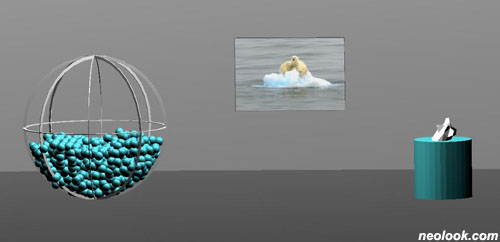
- 박형준_호흡:지구와 몸 Breath:Earth and Body_ 풍선, 철 구조물, 이산화탄소, 단채널 영상, 드라이아이스_가변크기_2017
박형준작가의 작업 「호흡, 지구와 몸」은 나의 신체에서 나오는 이산화탄소와 저기 북극에서 녹아내리는 거대한 빙하와의 관계성을 생각하게 한다. 기후변화는 나와 무관한 것이 아님을 상기시키는 그의 작업에서 흥미롭게도 다시 이산화탄소가 에너지원으로 작동하는 기구가 될 수 있음을 볼 수 있다. 기후변화의 문제를 과학의 도움으로 해결해 갈 수 있음을 암시하는 작업이다. 이는 우리의 미래가 그리 어둡지만은 않음을 가리킨다. ● 여기 화학연구원의 과학자와 참여한 작가들이 함께 보낸 지난 몇 달간의 작업은 기후변화의 주범인 이산화탄소를 생명의 에너지로 전환하고자 하는 탄소아트프로젝트의 일환이다. 멀리에서 또 가까이에서 응원해준 모든 지구인들에게 감사드린다. 화성에서 보낸 이들의 메시지를 모두 기억해주길 바라며... ■ 유현주
If Earth is a green planet, Mars is a red planet shined by sunlight. Facing survival crisis due to climate change, can humans survive in Mars, the planet that is most similar to Earth? As in the film, The Martian, will humans be able to grow potatoes, terraform Mars, and live happily after? Here a question is thrown out of curiosity: Why should we do so? Do we expect that Earth will be sickened and ruined? ● In "A message from Mars," 8 artists and scientists from Korea Research Institute of Chemical Technology (KRICT) think slightly different. They rather see Earth from Mars, reversely. KRICT scientists answer to the climate change from a perspective of the remarkable cutting-edge technology that creates various basic chemical materials out of rubbishy carbon dioxide. Artists as well acknowledge the same issue and find their own languages on ecological crisis with methodologies of chemical technology. ● In 「The Blued Trees Symphony」, Aviva Rahmani, an American ecological artist describes the continent after sea level rise and creates a map of stable habitats. With the map, trees are installed to play the music of nature as manuscript papers. ● Cheryl Safren, an American artist inspired by chemistry presents three paintings of 「Promontorium Protrusia」, 「Round 'n Round」, and 「Und 'n Undone」 to show the effect of carbon dioxide on plants. Her works question on an ecologically sustainable society today by showing the images of plant species strongly reactive to carbon dioxide rise and how they are dominating over plant species which are dependent to oxygen. ● Markuz Wernli, a Swiss artist and Sarah Daher, a dutch designer from Brazil are actively involved in a connection between Mars and Earth. Their biochemistrical experimentation on growing plants nourished by human urine maps out an ethno-horticultural approach, a way of surviving in waterless Mars. Here they invite audience to realize the way of 'aquaforming,' not 'terraforming.' ● Hyun Gil, from his early career, has worked on deriving chemical reactions from urea. His work 「Jasenghwa」 (indigenous/wild flower) shows how the artificial chemical of urea recognizes the self as a growing and blooming nature. The principal of ecological growth is identifiable in chemical organism. ● Kayoung An, in her work 「Dance of Carbon」 expresses aesthetic vitality of carbon which creates a new material. Perhaps the beginning of life in Mars also starts from carbon. ● Jisu Kim takes an oppositional stand to desertification caused by carbon dioxide in 「Breath Ⅱ」. The power of moss in afforestation shows an expectation for future that the vast fields both in Earth and Mars could be covered by life. ● 「Breath, earth, and body」 by Hyungjun Park draws attention on a relation between carbon dioxide from our body and melting iceberg in the North Pole. In his work, being reminded that the climate change as a relative issue, we can observe how carbon dioxide becomes the energy source again. Implicating that the climate change can be resolved by science, it suggests a bright future. ● The work that scientists and artists have done for months is a part of carbon art project which attempts to transform carbon dioxide, the main cause of climate change into a movement of life. I would like to appreciate all the supports of the earthmen from everywhere, with a hope that we keep the message from Mars in our minds. ■ Yoo Hyunjoo
Vol.20170123c | 화성에서 온 메시지-A message from Mars展

